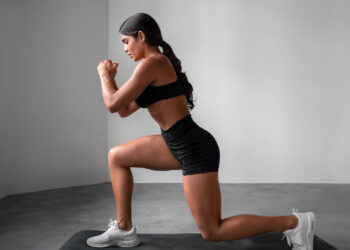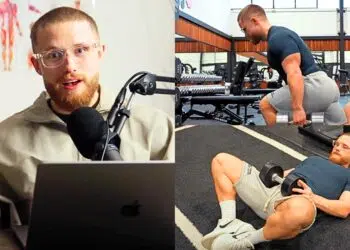Similar to planks, single leg glute bridges are an isometric core and glute focused exercise that challenges total body stability, core and glutes strength, and mental fortitude. It’s a simple technique that you can get on board with and adding a unilateral element will fire up your leg muscles, midsection, and upper body.
In this guide, we’ll go over proper technique, tips, benefits, variations, sets and reps, and programming this movement into your workouts.
How To Do The Single Leg Bridge
If you can do a plank then you can probably do the single leg bridge. In this section, we’ve included detailed step-by-step instructions and a video demonstration to ensure you get the most out of this movement.
Setup:
- Begin by laying down on a mat.
- Keep your back and head flat on the mat.
- Bring both legs together with knees bent, placing feet flat on the ground close to your buttocks.
Position:
- Extend one leg into the air, keeping the toe pointed to engage the quad of the elevated leg.
Execution:
- Press through the heel of the grounded foot.
- Elevate your hips upwards, using the strength of the grounded leg while ensuring the weight remains in its heel.
- The raised leg remains elevated throughout the motion.
Repetition:
- Lower your hips back towards the mat without fully resting them.
- Press the hips back up. This counts as one repetition.
- Perform this up and down motion 10 to 12 times.
Switch Sides:
- After completing the repetitions, lower the elevated leg and extend the opposite one.
- Again, keep the toe pointed on the raised leg and press through the heel of the grounded leg.
- Execute the bridge motion for 10 to 12 reps for this side.
Tips:
- The focus should be on the grounded leg’s heel when pressing up.
- You’ll feel the exercise working the glutes, hamstrings, and quads of the leg on the ground, as well as the quad of the elevated leg.
- Maintain a steady rhythm: up and down, up and down.
Benefits
What are the benefits of doing single leg bridges? Here are a few reasons to consider incorporating this exercise in your workouts.
Strengthen your core muscles
Everyone wants a flat, sexy tummy that they can show off during the summer months (and there’s nothing wrong with that). Ab training can help to build and strengthen the muscles of your midsection, but core training should aim to achieve more than that.
A strong and developed core is also important for stabilizing your spine and protecting your lower back during physical activities, healthy posture, aging, balance, and being able to perform everyday tasks well into our older years (1).
Level Up Your Fitness: Join our 💪 strong community in Fitness Volt Newsletter. Get daily inspiration, expert-backed workouts, nutrition tips, the latest in strength sports, and the support you need to reach your goals. Subscribe for free!
Keep your hips strong and mobile
Leg bridges are a good hip strengthening exerciser and you’ll quickly find out if you’re lacking in this area. These muscles are just as important for physical performance as they help maintain core stability, proper posture, and movement of the lower body muscles.
Train functionally
The core muscles are crucial for supporting physical activities whether you’re an athlete, active person in general, or simply want to maintain a healthy body structure for as long as you can. The balance and stability required to maintain position on the ball makes this a functionally useful movement that transfers to actual real life situations.
Try these 10 Best BOSU Ball Exercises
Unilateral lower body exercise
What is a unilateral exercise? Lunges, alternating biceps curls and single leg bridges all have one thing in common. You’re working one side at a time. Everyone should include this form of training in their workout regime because it challenges not just the body but also the brain to focus on balance, coordination, muscle contraction, plus it requires more core engagement, joint stability, and you’ll be able to identify and correct left to right side muscle imbalance.
This is not only beneficial for athletes though. Humans need to have functional capabilities and as we get older, it’s even more important to maintain these aspects of fitness and performance.
Drawbacks
What are some cons of single leg bridges?
Not ideal for advanced exercisers
If you have training experience and have developed a strong core and upper body, single leg bridges may be challenging but not enough to really elicit much results. However, it is a great way to maintain strength in your midsection and hip muscles. Of course, your body weight is a factor in how long you can maintain the single leg bridge position.
Not as easy as it looks
You may find yourself breathing a little heavier or struggling a little more than you thought you probably would unless single leg bridges are a regular exercise in your workouts. Many of us would be surprised to know how weak we really are in the core and hips. Good thing this movement will help to improve these areas. But don’t underestimate it or any of its variations going in.
Common Mistakes
These are some form mistakes that you want to avoid.
Letting the hips sink down – Planks are an isometric push-up on your forearms. In other words, they both require the same strong body position to maximize muscle engagement and prevent losing energy from bad technique. You want to form a straight line with your body and make sure your butt and shoulders are moving up and down together.
Poor form – Looking up, arching your back, lifting your butt too high, failing to keep your core tense and letting your hips twist and shift are all things you don’t want to do. All of these form mistakes will drain good energy that you could be putting into single leg bridges. The body needs to move as one unit to be strong and efficient.
Level Up Your Fitness: Join our 💪 strong community in Fitness Volt Newsletter. Get daily inspiration, expert-backed workouts, nutrition tips, the latest in strength sports, and the support you need to reach your goals. Subscribe for free!
Doing them too quickly – For your body to really benefit from single leg bridges, the movement should be performed using a moderate tempo at the very least. Going too fast will make inexperienced exercisers have sloppy form and neglect to do the exercise symmetrically for both sides.
Variations
What are some similarly effective or superior variations or alternatives that offer their own unique benefits?
1. Basic plank
You can’t go wrong with a basic plank but it’s more of a beginner exercise or test of muscular endurance and mental grit. If you can hold a plank for one minute straight then it’s probably time to try something new and harder.
Related: The Best Plank Progressions and Variations for Stronger Abs
2. Single leg reverse plank
Reverse planks are an advanced version of the conventional variation that you use to perform single leg bridges. Instead of being supported by your forearms and toes, you’ll flip over and hold yourself up with extended arms and heels. Try it out and you’ll immediately notice that it’s more uncomfortable which means it’s going to be more beneficial for your core muscles.
3. Single leg bridge on stability ball
A slightly harder version of the basic plank but an easier progression before a full on single leg bridge, you can utilize a stability ball to support your weight although you will still need to balance and stabilize your body.
4. High plank leg bridge
You can also do leg bridges from a push-up or high plank position. It’s just as challenging to hold yourself up and you can elevate your feet to make it more effective.
5. Bird dog
Named after a half dog half flying bird position and rightly so, bird dogs are the next step up from single leg bridges. Your weight is supported on palms and toes in a push-up position while one arm and the opposite side leg is extended and held straight out for an isometric repetition.
Also check: How To Do The Single Leg Glute Bridge
Programming Single Leg Bridges
Like most plank variations, we recommend doing single leg bridges after a core workout or any type of training session. That’s because they’re an isometric exercise that you can use as a finisher to fatigue the muscles without having to do much movement.
Additionally, you can do a few timed rounds after a workout and then call it a session! This is actually a common training strategy with plank movements.
How Many Sets To Do?
You won’t need more than 2-4 sets of single leg bridges to torch your core and glute muscles. As for the duration, you can aim for 5 seconds per side. But the most important thing is to take it slow and focus on mind-muscle connection.
Muscles Worked
Single leg bridges are a full body exercise that involves every muscle from your feet all the way up to your neck. We’ve included brief descriptions of each one in this section.
- Gluteus Maximus – The butt has three main muscles – gluteus maximus, medius and miminus. However, the gluteus maximus is not only the largest of the three but the biggest muscle in the human body making up most of the butt and hip’s shape. What it does is extend and externally rotate the thighs plus supports upright posture.
- Obliques – Running alongside either side of the abdominals, the external and internal oblique muscles help us to twist to either side.
- Rectus abdominis– Also called the abs, rectus abdominis are the washboard looking muscles on the anterior torso resembling a 4, 6, or 8-pack unless they’re buried under body fat. They’re a long, flat slab of muscle and their role in the body is curling the upper and lower torso toward each other.
- Quadriceps – The muscles that give us that teardop shape on the front thigh, the quadriceps or quads for short has four heads – rectus femoris, vastus lateralis, vastus medialis, and vastus intermedialis. Hip flexion and knee extension are how the quads function. Plus they are involve when we walk, to support our posture, and function of the spine and pelvis.
- Hamstrings – Doing the opposite of the quadriceps, the hamstrings extend the hips and flex the knee joint. Made of three muscles – biceps femoris, semimembranosus, semitendinosus, the hamstrings are a strong athletic muscle and sitting opposite the quads, you can see why the thigh is a powerful body part.
- Serratus Anterior – Commonly called a boxer’s muscle, serratus anterior is a fan-shaped situated along the outer ribs between the pectoralis and latissimus dorsi. It moves the arms forward and works with the lat muscles to raise the arms overhead.
- Tensor Fasciae Latae – The tensor fascia latae (TFL) is a part of the thigh muscle and it assists in the movement and stabilization of the hip and the knee. It also internally rotates and abducts the hip with the gluteus medius and gluteus minimus muscles.
Bottom Line
Planks are a great exercise for all experience levels, however, at some point you’ll need some variation to make them more challenging. Fit single leg bridges in your routine to benefit from additional glute stimulus, enhanced core activation and more overall total body stability. If trying it for the first time, we think you’ll be surprised at how tough they are!
Interested in measuring your progress? Check out our strength standards for Glute Bridge, Lunge.









